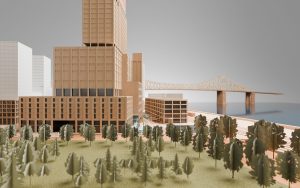While construction activity is occurring across ºÚÁϳԹÏÍø, the overall pace of construction employment growth will be slower over the next decade and changes in employment can vary significantly by province, indicates the latest labour market forecast released by BuildForce ºÚÁϳԹÏÍø.
According to the 2017-2026 National Construction and Maintenance Looking Forward forecast, after two years of decline, construction activity is expected to edge slightly higher this year, but overall growth will be slower and uneven across the provinces as new residential activity declines and major projects start up and wind down.
"It’s really the rate of growth we’re talking about that is slowing but there’s still a fair bit of construction activity happening across the country," said Rosemary Sparks, executive director of BuildForce ºÚÁϳԹÏÍø, which provides labour market data and analysis for the construction industry.
"It’s difficult to talk about ºÚÁϳԹÏÍø as one thing, you have to look at each of the provinces. Every province has a bit of a different story. How they are experiencing what is happening in construction varies. The years in which things change and we start to see turnarounds or downturns are different."
The forecast anticipates Ontario will see some expansion of employment in construction over the next few years, out to about 2020 when things are going to level off. Major transit and transportation infrastructure and nuclear refurbishment and utility projects are expected to sustain the province’s construction workforce over the next 10 years. British Columbia is poised to have fairly significant employment growth over the next few years, Sparks stated.
Major projects such as proposed transportation, pipeline, mining sector and LNG projects will boost the province’s construction workforce by 24 per cent, which is almost 17,000 workers over the next five years, the forecast indicates. Industrial, commercial and institutional building will also continue on an upward trend while new housing is expected to slow down this year following an extended period of expansion.
"It’s potentially the most rapid rise we’ve seen in B.C.’s construction workforce in the past decade," said Sparks.
Manitoba has some fairly large hydro and transmission projects that are creating employment opportunities as well.
"For the next few years they’re going to be fairly strong and then things are going to start to taper off a little bit," Sparks noted.
Pipeline, marine terminal and hydro dam refurbishment projects will increase employment demands in New Brunswick. Saskatchewan is also holding its own, she added.
"They’re (Saskatchewan) going to see their construction employment sustained at fairly high levels throughout the period," Sparks stated. "There will be some really modest gains in new home building and they’re probably going to end the period fairly close to where they started the forecast period."
In comparison, Alberta and Newfoundland and Labrador are seeing a decline in demand for labour due to weaknesses in the resource sector, explained Sparks.
While there is a possibility of more job losses in Alberta by the end of 2017, it is anticipated that there will be a turnaround as the price of oil stabilizes and the economy starts to improve.
"We think in the very short term for Alberta there’s some more job losses but at a much slower pace than we have experienced in the last few years. Then things will start to turn around in a kind of staggered way," said Sparks.
"We’ll see some improvements in residential construction in Alberta in 2018. Then we’ll start to see some institutional/commercial kinds of activity start to go up and by 2024 we think we might start to see a turnaround in the oilsands activity and the heavy industrial and resource based kind of construction."
The one common thread across the country is the demographics, Sparks noted. According to the forecast, there is the potential for about 248,000 skilled workers to retire by 2026. One of the biggest challenges across the industry this decade is offsetting the retirement of an estimated 21 per cent of the country’s construction workforce, Sparks added.
"This is a pretty significant time frame because many of the baby boomers will probably be out of the workforce by the end of 2026," Sparks noted.
"This is the period when we’re going to feel the loss of those baby boomers."
It’s easier to attract people to an industry when things are really strong and there is significant growth happening, she added.
"We have some challenges when we think about trying to bring new people into the industry and training them and keeping them employed so that when things are more robust, when things do turn around, we’ve got skilled workers there ready to go," said Sparks.
"It’s a big planning and recruiting and training exercise that has to happen within the industry to ensure that we have that sustainable workforce."
SIDEBAR
Key regions where new job opportunities are anticipated:
Non-residential
• New Brunswick: Pipeline, marine terminal and hydro dam refurbishment projects increase employment demandsOntario: Major transit infrastructure projects and nuclear refurbishment projects add to employment opportunities across the forecast period
• Manitoba: Major hydro development and transmission projects sustain employment requirements
• British Columbia: Pipeline, LNG, transportation and mining projects drive job growth
Residential
• Housing activity is expected to moderate in the two largest residential markets – British Columbia and Ontario
• Over the short term, residential employment requirements strengthen in Alberta and Manitoba and continue to track downward in Quebec as well as Atlantic ºÚÁϳԹÏÍø over the long term
• Residential construction employment is expected to decline by seven per cent, only partially offset by steady but moderate increases in renovation activity










Recent Comments
comments for this post are closed